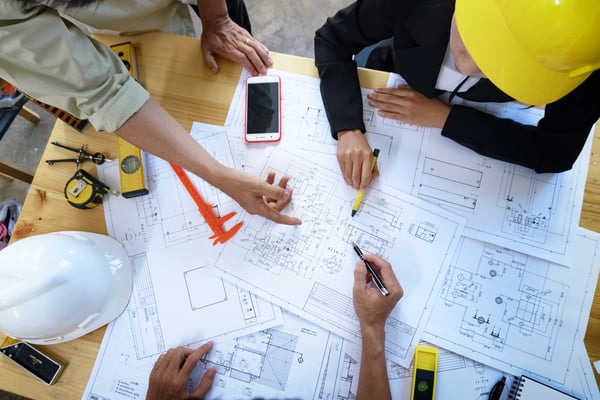Construction Safety Officer: Responsibilities and Duties

In recent years, builders and contractors have been paying more attention to workplace safety. A company that promotes safety measures will have a higher retention percentage in their workforce. Safety measures also create an adequate working conditions, resulting in better performance and a pleasant work environment. Construction safety officers are responsible for creating and implementing safety measures in constructions.
A construction safety officer implements safety policies and regulations in an construction site, and makes sure they are followed. Their main responsibility is creating a safe environment for construction workers, but they may take additional roles and responsibilities during a project.
Professional construction administration can make your building projects safer.
Construction safety officers work closely with the Occupational Safety and Health Administration (OSHA). OSHA is part of the United States Department of Labor, and the organization works to create safe and healthy working conditions. OSHA establishes and enforces standards, while conducting public outreach, ongoing education, and assistance.
Nowadays, the construction industry is moving towards augmented reality, BIM, and other technologies that will change how safety officers interact with a project.
- These emerging technologies can help detect hazardous situations during the planning stages of a project.
- Safety officers can rely on them to create mitigation strategies and response plans for accidents.
- Inspection technologies are also evolving day by day, and some companies use drones or UAVs to conduct safety audits and inspections.
The tasks of a construction safety officer include making sure that construction workers take proper safety measures. They must have full knowledge about safety and security methods, construction equipment and materials. Since many construction activities are performed outdoors, there are many external hazards, such as the weather at building sites.
Roles of Construction Safety Officers
Construction safety officers create, implement and enforce safety policies that reduce the risk of accidents. It is their responsibility to determine which policies are necessary for the job site and how to enforce them. Safety officers must have updated knowledge about safety methods and standards. This way, they can keep policies up-to-date and renew them when new risks are discovered.
Safety officers carry out inspections on site to determine hazardous situations. They must also create regulations and policies to overcome them. For example, broken equipment and flawed tools create a hazard for construction workers, and safety officers are responsible for detecting those issues. They also specify the adequate personal protective equipment needed, and make sure that workers know how to handle tools and equipment properly.

Accident investigation is also among the tasks of construction safety officers. The main objective of a construction safety officer is preventing work accidents, but if an accident occurs they must investigate and gather evidence to determine its causes. Once an investigation takes place, they will document findings and recommendations to prevent similar accidents from happening again.
Safety officers are responsible for reviewing and meeting all the federal and state requirements for record-keeping. Safety officers must fill out the OSHA form 300, which is a summary of all injuries that resulted in lost work time and other issues. They also make sure that certain OSHA regulations are taken care of, such as displaying the proper safety posters and other documents.
Summary of Construction Safety Officer Responsibilities
- Continuous inspection of project sites, to ensure a hazard-free environment
- Assessment and approval of subcontractor safety plans
- Verification of tools and equipment to ensure good quality
- Promoting safe practices on site
- Creating and enforcing safety guidelines and programs
- Carrying out drills and exercises on managing emergency situations
- Conducting investigations on accidents
- Verifying that all safety reports are submitted to related government institutions.
- Responding to workers’ safety concerns
- Manages all communications with government departments in regards of safety
- Arranges OSHA-mandated evaluations of the site
- Coordinates all issues regarding hazardous materials or waste
- Assisting with the preparation of a construction health and safety plan
- Attending project planning meetings and collaborating with construction managers
- Establishing and maintaining health and safety communication structures
- Testing effectiveness of site emergency response plans
- Continuous monitoring of all safety related documents, reports and issues to keep them updated.
Construction Safety Officer Training
Construction safety officers must stay updated with the latest information regarding safety procedures, and they are required to attend training programs. Safety officers need to be proactive and stay ahead on safety and environmental hazards.
By staying updated, safety officers can determine the best training programs for workers on determined job. The safety officer provides training to employees on safety topics required by OSHA. These include fire prevention plans, machine guarding and hazardous materials handling. Safety officers may solicit feedback from workers and use it to improve existing plans or create new onews.
The key role of construction safety officers is keeping a safe environment for workers during all stages of a project. Having a proper safety plan is necessary to deliver a project on time and within its budget. Every accident causes disruption to the project, and the human consequences can be severe - accident prevention should be a project priority.
Nearby EngineersNew York Engineers has a MEP design track record of 1,000+ projects. Contact us via email (info@ny-engineers.com) or phone ((786) 788-0295212-575-5300), and make sure your building systems meet codes.

Michael Tobias
Michael Tobias, the Founding Principal of NY Engineers, currently leads a team of 150+ MEP/FP engineers and has led over 4,000 projects in the US
Related Posts
Join 15,000+ Fellow Architects and Contractors
Get expert engineering tips straight to your inbox. Subscribe to the NY Engineers Blog below.

